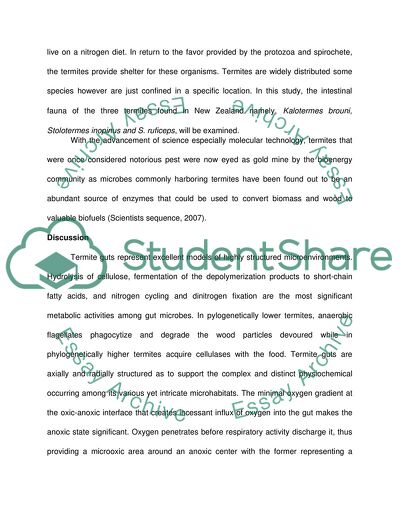
- Home
- Free Samples
- Premium Essays
- Editing Services
- Extra Tools
- Essay Writing Help
- About Us
- Studentshare
- Subjects
- Miscellaneous
- A symbiotic mnage a trois:New Zealand termites, protozoa and prokaryotes
A symbiotic mnage a trois:New Zealand termites, protozoa and prokaryotes - Essay Example

- Subject: Miscellaneous
- Type: Essay
- Level: Undergraduate
- Pages: 4 (1000 words)
- Downloads: 0
- Author: monique53
Extract of sample "A symbiotic mnage a trois:New Zealand termites, protozoa and prokaryotes"
These bacteria play a special role in converting wood into sugar which nourishes the termites (Rowe, 2008). Inside the termites are protists and prokaryotes. These three organisms develop dependence on each other. Wood termites utilize cellulose form wood as source of energy. Wood termites however like all animals cannot digest cellulose. They depend on one-celled protozoa which carry out the process for them (Ramsay, 1995). The ingested wood passes through the fore and midgut before entering the digestive paunch in the hindgut.
Within the digestive paunch the protozoa ingest the wood and intracellular digest the cellulose. The protozoa inside the termite gut also have a symbiotic relationship with spirochete bacteria. The spirochete bacteria produce the necessary digestive enzymes for digestion. Within a single termite species, diverse spirochetal species could be found. All spirochetes identified within the termites belong to the genus Treponema (Ohkuma, 2001). The spirochete bacteria are attached to the external surface of the protozoa.
The spirochete bacteria are nitrogen-fixing bacteria. Nitrogen fixation is very important since termites live on a nitrogen diet. In return to the favor provided by the protozoa and spirochete, the termites provide shelter for these organisms. Termites are widely distributed some species however are just confined in a specific location. In this study, the intestinal fauna of the three termites found in New Zealand namely, Kalotermes brouni, Stolotermes inopinus and S. ruficeps, will be examined.
With the advancement of science especially molecular technology, termites that were once considered notorious pest were now eyed as gold mine by the bioenergy community as microbes commonly harboring termites have been found out to be an abundant source of enzymes that could be used to convert biomass and wood to valuable biofuels (Scientists sequence, 2007). Termite guts represent excellent models of highly
...Download file to see next pages Read More
- TERMS & CONDITIONS
- PRIVACY POLICY
- COOKIES POLICY